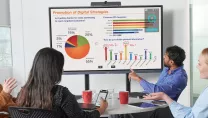Meeting rooms fulfill many different needs within a business and choosing the right AV configuration is vital to their success. Here, Markus Eisemann, Visual Solutions, Sharp DACH and Ronald Huijbregts, Sales and Marketing Manager, Visual Solutions, Sharp (Benelux) define the different types and highlight the benefits of bespoke AV solutions.
A meeting room is an expensive space in a company. Not because of the cost of the equipment, but because of the cost of having people sat together for a long time – at least 17 hours per month according to our research.
That’s about £3,000 per employee per year for those earning an average salary. However, those who attend the most meetings tend to be higher wage earners and when they are in a meeting they are not generating revenue.
There’s an opportunity cost to consider too.
Meeting areas need to be set up to make people as productive as possible, with the right Audio Visual tools. When people are buying a commercial display from Sharp they are usually replacing a consumer display or a projector, which doesn’t have the connections or interactivity that they now need, and they want to upgrade to a professional solution that will support them properly.
If you are considering purchasing a new meeting room display, these are the questions, we believe, to consider and discuss with a sales person:
1. Do you need an interactive display or a ‘standard’ or non-interactive display? Will you be using the display to visualise information, or to interact with it?
2. Choosing the right panel for the size of your meeting room is vital, so you’ll be asking, how big is your meeting area? What’s the viewing distance? What size display will work best?
3. If the display is to be used by the wider office, you will need to ask whether the display is easy-to-use? Is it positioned where everyone can view or access it?
4. Do you need more than one display, and a solution to mirror your content? This is particular important in larger or non-conventionally shaped meeting rooms, as well as spaces where you regularly switch between presenters.
5. How will you get information on to the digital display? Will people bring their own devices (BYOD) into a meeting and need to connect to the display? Alternatively, do you work on USB sticks?
6. What file formats will be displayed?
7. What information will be displayed? Do you need ultra-high 4K resolution to see a great amount of detail?
8. What is your IT environment? Will the display fit into it? Is your display recommended by any solutions providers you are using?
9. Will your presentations and meetings also involve audio? Look for a display that comes with built-in speakers, or offers the capacity to add additional speakers.
10. Will the display be used in mission critical locations? Will the display be accessed 24/7?
As you can see, there is more to choosing a display for your meeting room than simply choosing the largest panel size. By Exploring our extensive range of Sharp Interactive Displays and discussing your needs and working with a dedicated Sharp reseller, you will soon have the best solution for your meeting needs.





